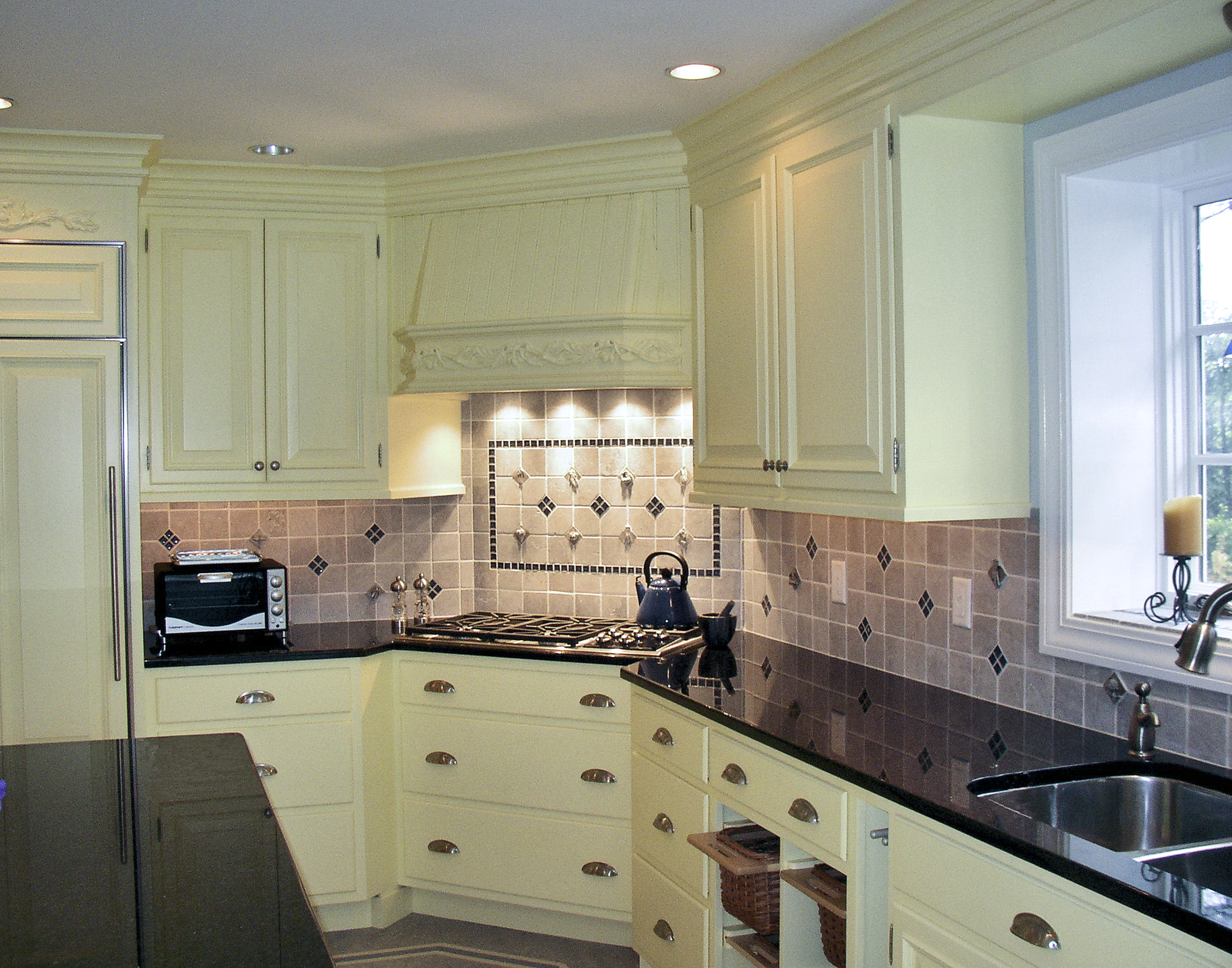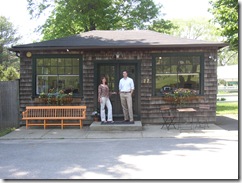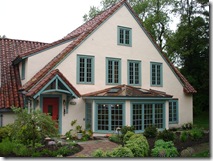Posts in Category: kitchen redesign
Eco-Friendly Interior Finishes for Kitchen and Bathroom Renovations
This past month I participated in the Hamilton Wenham Green Speaker Series which took place at the Hamilton Wenham Public Library. My focus was Eco-friendly interior finishes for kitchen and bathroom renovations. As I was preparing this presentation, it became evident that I could stand before my audience and provide them with factual information presented in a power point format or I could share my personal story of how I became interested in specifying less toxic finishes for my clients along with the facts. The later seemed to offer a more interesting venue.
I have shared in a past blog about how I became ill after moving into two of the homes we had lived in. The focus of that blog was about the outgassing of VOC’s (volatile organic compounds) when paint dries. (Smelly walls, what’s that all about? July 2009) Upon learning about VOC’s and outgassing with respect to paint, I was then interested to find out what other items may have contributed to my illness. Through the process of Google searches, speaking with experts in the field of Green Design and reading accounts of similar chemical sensitivities, I was on my way to learning how to create healthier environments for myself as well as my clients.
The first home my husband and I purchased was in Lynn, MA in the late 1980’s. It was a Victorian that had been gutted and was in the process of being renovated when we first saw it. Not only did it have fresh paint on the walls, but there was new nylon carpeting put down with toxic adhesives, restored wood flooring with polyurethane, plastic laminate kitchen and bath cabinets and countertops with formaldehyde and toxic glues. I was ill for 3-6 months. The doctors could not figure out what was wrong with me. Could it be sinus or neurological? They gave me medication – but I think my system eventually just adapted to the environment.
Our second home was in Georgetown, MA in the early 1990’s. It was new construction. Of course, we were excited to have a new home! What we didn’t realize was that I was going to get sick again for an extended amount of time due to the finishes applied throughout this home as well. Since it was new construction, we also had a very tight house. The only difference between this home and our previous one was instead of newly finished wood floors, we had vinyl flooring and adhesives to deal with. We had the same plastic laminate cabinets and counters, nylon carpeting on the second floor bedrooms and lots of painted walls.
In 2000 we move to Hamilton, MA. The home was a Victorian summer home that had been converted to year round living in the early 1930’s. When we moved in – nothing had been done to the interior of the house for years. There were painted plywood cabinets in the kitchen, beautiful hardwood floors throughout that had an older finish on them, the paint on the walls was several months old and there was ceramic tile on the floors of the bathrooms. I was healthy for the first time after moving into a new home! I was too busy at the time to put much thought into questioning why I wasn’t getting sick with this move. That light bulb would go off in a few years.
When I decided to begin my own interior design practice focusing on residential design, I knew that I had wanted to work with clients to provide beautiful and functional spaces for them to enjoy, but I also knew there was something more. In the beginning, I wasn’t quite sure what that was, but I trusted that eventually it would come to me. The aha moment came when I started hearing about Green Design and how it was more than just specifying sustainable products, it was also about specifying healthy products. That was it: I would learn as much as I could about how to bring healthy products into my clients homes. Not only in terms of finishes, but cleaning products, fabrics, air purifiers and humidifiers and even food. (I have been a work for share/CSA member for 8 years at Green Meadow Farms in Hamilton, MA. They share with the community organic produce/meats and lifestyle choices)
Through my interior design business, I have had the privilege of designing and working to date on two Green Kitchen renovations. Here is a listing of some of the features we were able to introduce into these spaces (they go beyond just finishes): Energy Star appliances, organic wall paint, no VOC (volatile organic compounds)paint, recycled glass/ceramic wall & floor tiles, LED (light emitting diode) for under cabinet and cove lighting, energy efficient dimmable CFL (compact fluorescent lighting) lighting, Richlite (compressed paper based) countertops, poured concrete countertops, radiant heat under the flooring, cabinetry: FSC (Forest Stewardship Council) cherry and maple cabinetry, with a water based natural finish, no VOC painted finish on office, bathroom & island cabinetry, flooring: Marmoleum, linoleum product, backsplash: reclaimed tumbled stone with recycled metal and crushed glass accent tiles.
My intention is to share the information I have gathered with my clients, friends and family. There are so many products demanding our attention, why not purchase those that are not harmful to us nor our environments. I will be posting the video recorded at the library within the coming weeks that shares more information about specific companies and their products. If you are interested in viewing it now, go to: HWCAM.org, type in Lisa Kawski, it will bring up my show, click on the title, it will show the schedule, click on WATCH NOW.
As always, if you have any questions regarding green interior finishes, please feel free to contact me design@lmkinteriorsltd.com or call (978)335-1140.
Integrated Building Design
When Matt Ulrich and I decided to share an office three years ago, I don’t think we imagined that our teaming up would lead to the current publication of our Connect-the-Dots e-newsletter (along with fellow architect, Juli MacDonald) nor the potential for combined project work. We saw it as a great opportunity to move our home-based businesses into an office space where we each would gain valuable “curbside” exposure with our location on a main street in the community. We had spoken about how beneficial it would be to pass referrals to each other through our client bases, but our main goal was to grow our businesses.
Three years later, not only have we grown our businesses, but we have also had the pleasure to work together on a major kitchen renovation that incorporated Integrated Design principles. At the time, my thought was to bring a team of trusted building trades together to provide great service for my client. I assumed that task as part of my project management responsibilities. I hadn’t realized there was a term other than working in collaboration to tie us all together.
Integrated Building Design Residential Project
I had been working for several years with a client on various rooms within their home; formal dining room, living room, master bedroom/bathroom, various guest and children’s bedrooms and bathrooms, so I was very excited when they said they were ready to renovate their kitchen. Not only to redesign the space, but they wanted to incorporate green design building principles, practices, materials and interior finishes. I had asked if I could introduce them to several professionals that I knew that would be able to design and construct this project. They agreed to meet with the various disciplines.
I introduced them to:
- Matt Ulrich of Matthew Ulrich Landscape Design
- Juli MacDonald of Greenbridge Architects
- Dave West of Meadowview Construction
Along with myself, Lisa Kawski of lmk interiors, ltd., we formed the the design and construction team. We began working as an integrated group from the onset of the project.
You may be wondering what the difference is between Integrated Building Design and the more traditional design process. Let me first define my views of the traditional design process and follow with Integrated Building Design.
- Client hires an architect to design their renovation. Architect designs the space and may introduce the client to builders, engineers, specialists during the initial design process, or they may not. Eventually a builder gets involved, bringing in their various subcontractors. Space gets built. The client may engage the services of an interior designer to assist them with finish and fixture selections, but often the builder will direct the client to some of their sources for this stage. If the client had initially allocated specific monies, they may hire an interior designer and possibly hire a landscape designer for the exterior. Often, these two professions do not get hired until several years later. Money was not budgeted at the onset of the project to allow for a complete renovation.
- Integrated building design (according to Wikipedia) is “a collaborative method for designing buildings which emphasizes the development of a holistic design.” This is teamwork at its best. Multiple disciplines (architect, interior designer, builder, landscape designer, engineers, etc.) come together in the initial planning stages of design to achieve a cost-effective, resource-efficient and comfortable result for the client. There is no script for the perfect integrated design process, but there are several levels of decision making that must take place at the start of conceptual design, while the design is being refined, during design development, and during construction. Because every design decision produces a multitude of effects, integrated design requires an understanding of the interrelationship of each discipline. It requires all of the participants to think holistically about the project, rather than focus solely on each individual part.
Whether it be new construction or a renovation, approaching the design/build of a building as an interdependent system; where the goal is to make sure that all facets work in harmony rather than against each other, benefit both the client and all of the disciplines involved.
Integrated Building Design, Our Outcome
Out of that project; Matt, Juli and I established Connect-the-Dots. Attending networking events and building trade meetings, we realized we enjoyed working together as well as learning more about sustainable building practices. Our desire to offer clients a one-stop resource to assist them with their design needs would prove beneficial through this pairing. Our mission is: We are a professional collaboration between three friends who share a passion for green design, each from our own perspective: architecture, landscape design and interior design. Our goal is to share useful and up-to-date information on green design, filtered through our distinct, but connected points of view. Through our e-newsletter, which we have been sending out since last May, we connect the subscriber to our individual blogs. We are very excited to announce the launch of our micro website this month: www.ctdcollaborative.com. Please share this web address with those that you think would enjoy it. They can subscribe to receive our e-newsletter on the site.
As always, if you have any questions, please feel free to contact me at (978)335-1140 or design@lmkinteriorsltd.com.
Hamilton Wenham Green Presents:
GREEN SPEAKER SERIES
I am a member of the Hamilton Wenham Green Business Group. On March 3rd, Wednesday, at 7 pm I will be presenting Eco-Friendly Interior Finishes: ideas for implementing eco- friendly materials in the redesign of both kitchen and bath.
location: Hamilton Wenham Public Library @ 14 Union Street South Hamilton – (978)468-5577, lectures are free and open to the public, please come.







